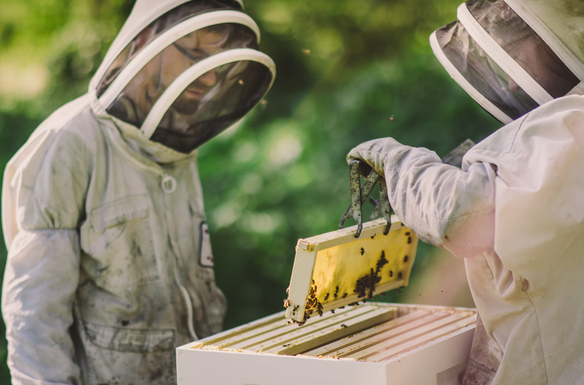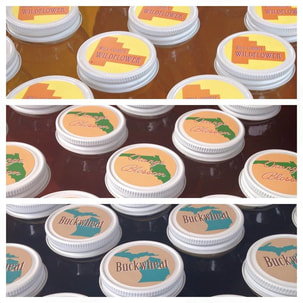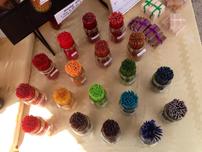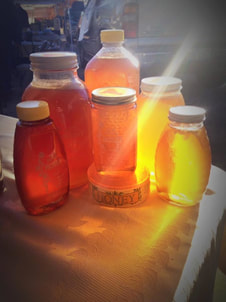Where is our honey from?

All of our local honey is collected from farms within a 25 mile radius of Frankfort, Illinois. Local farmers rent our hives to keep on their properties to increase the yield of their crop production thanks to the bees pollination work. Bees only have a 2 mile flight range, so we can be fairly certain of what kind of flowers our bees are pollinating. In this area, the primary honey variety is Wildflower, though depending on the farmers fields, the honey may be more of a Clover or Alfalfa variety. It depends entirely on what the bees are going after!
We do have "seasonal" honey throughout the year that we collect from different parts of the country, and we extract and label it separately so there is no mixing into our local honey. Some of our other varieties include Buckwheat, Orange Blossom, Blueberry, and Cranberry honeys. The availabilities of these varieties are not guaranteed, but we like to try and keep at least one seasonal option available throughout the market season to keep an assortment of flavors available for our customers.
We do have "seasonal" honey throughout the year that we collect from different parts of the country, and we extract and label it separately so there is no mixing into our local honey. Some of our other varieties include Buckwheat, Orange Blossom, Blueberry, and Cranberry honeys. The availabilities of these varieties are not guaranteed, but we like to try and keep at least one seasonal option available throughout the market season to keep an assortment of flavors available for our customers.
Is this honey raw? What does "raw" mean? |
How long does honey last? |
Why does honey thicken and granulate over time? How can I prevent/reverse it?
All natural/raw honey will crystallize over time. This is actually a good sign! If your honey never ever gets cloudy or crystallizes, there's a good chance it was processed or heated to the point of "burning" the honey. Many honey companies will do this if they sell to chain grocery stores in order for the honey to have shelf appeal, as it will stay clear forever and look prettier, even if it means destroying the honey's flavor and natural benefits.
The crystallization process is not a predictable thing, and is most dependent on the varieties of pollen that make up the honey. From our own observation, we have found that honey collected in the Spring tends to stay in its liquid state a lot longer than honey collected in the Fall. This is because of the change in flower varieties and differences in moisture content. Colder temperatures can slow the process of crystallization, but keeping it at a steady temperature also helps. Large or rapid temperature fluctuations will accelerate the process of crystallization.
Crystallization can be reversed by gently warming the honey. If you have a small enough jar, you can remove the cap and put your glass jar in the microwave on the defrost setting for 30 seconds at a time, stirring in between heatings. Otherwise, no matter what size jar, you can sink it into a pot of warm water on the stove top. Do not let the water boil! In order to keep the honey in its most nutritious state, the warming must happen very slowly and gently (a rule of thumb that we recommend is never getting the honey over 140 degrees). As soon as it is back to a liquid state, remove it from heat. It should stay that way for at least several weeks after.
If you don't mind the granulated texture (which is much easier to spread than liquid honey), you can also take crystallized honey out of the jar as is, and it will melt in your tea or coffee or on your toast on its own, without any stove or microwave assistance. Sometimes beekeepers allow the honey to form crystals, and market it as Creamed Honey, as it is still completely edible, despite its visual and textural differences from liquid raw honey.
The crystallization process is not a predictable thing, and is most dependent on the varieties of pollen that make up the honey. From our own observation, we have found that honey collected in the Spring tends to stay in its liquid state a lot longer than honey collected in the Fall. This is because of the change in flower varieties and differences in moisture content. Colder temperatures can slow the process of crystallization, but keeping it at a steady temperature also helps. Large or rapid temperature fluctuations will accelerate the process of crystallization.
Crystallization can be reversed by gently warming the honey. If you have a small enough jar, you can remove the cap and put your glass jar in the microwave on the defrost setting for 30 seconds at a time, stirring in between heatings. Otherwise, no matter what size jar, you can sink it into a pot of warm water on the stove top. Do not let the water boil! In order to keep the honey in its most nutritious state, the warming must happen very slowly and gently (a rule of thumb that we recommend is never getting the honey over 140 degrees). As soon as it is back to a liquid state, remove it from heat. It should stay that way for at least several weeks after.
If you don't mind the granulated texture (which is much easier to spread than liquid honey), you can also take crystallized honey out of the jar as is, and it will melt in your tea or coffee or on your toast on its own, without any stove or microwave assistance. Sometimes beekeepers allow the honey to form crystals, and market it as Creamed Honey, as it is still completely edible, despite its visual and textural differences from liquid raw honey.
Why does honey come in different colors?

We think beewayhoney.com answers it best: "The specific flavor of each honey depends on the particular nectar the bees gather. When bees collect nectar from large growths of one certain blossom, the honey is labeled 'single-flower' honey; examples are clover, lavender, sunflower and star thistle. Sometimes bees gather from a variety of sources, making multi-floral honey called 'wildflower.' Flavors range from light and fruity to tangy and rich.
As a general rule, light-colored honey is mild in flavor, while dark honey is more assertive. Clover, acacia, basswood and orange blossom are some of the lighter varieties: they make wonderful sweeteners for cereal, tea, fruit salads and salad dressings. In the middle range, you find star thistle, Florida tupelo, sage, alfalfa and honeys from berry blossoms, which add a stronger flavor. Dark honey, such as buckwheat is used like brown sugar or molasses; it works well on oatmeal and in pancakes and whole-grain breads. Flavored honeys are those to which flavoring agents, such as fruit or herb essences, have been added. In a study that analyzed 19 samples of honey from 14 different floral sources, University of Illinois scientists found that honey made from nectar collected from Illinois buckwheat flowers packs 20 times the antioxidant punch as that produced by bees that lap up California sage. Clover, perhaps the most common plant source tapped by honey bees, scored in the middle of the rankings."
As a general rule, light-colored honey is mild in flavor, while dark honey is more assertive. Clover, acacia, basswood and orange blossom are some of the lighter varieties: they make wonderful sweeteners for cereal, tea, fruit salads and salad dressings. In the middle range, you find star thistle, Florida tupelo, sage, alfalfa and honeys from berry blossoms, which add a stronger flavor. Dark honey, such as buckwheat is used like brown sugar or molasses; it works well on oatmeal and in pancakes and whole-grain breads. Flavored honeys are those to which flavoring agents, such as fruit or herb essences, have been added. In a study that analyzed 19 samples of honey from 14 different floral sources, University of Illinois scientists found that honey made from nectar collected from Illinois buckwheat flowers packs 20 times the antioxidant punch as that produced by bees that lap up California sage. Clover, perhaps the most common plant source tapped by honey bees, scored in the middle of the rankings."
What are honey straws?

A Honey Straw is a unique, heathy, energy packed natural treat. It's basically a drinking straw filled with natural and flavored honey, and sealed on the ends. A simple bite pops the straw open and each straw contains about 5ml (a teaspoon) of honey. They can also be used to sweeten tea/coffee, as party or wedding favors, or as a substitute as candy for kids.
While we do not have the equipment to make our own honey straws, we do order them from a professional apiary company located in New York. Nutritional facts are available upon request.
While we do not have the equipment to make our own honey straws, we do order them from a professional apiary company located in New York. Nutritional facts are available upon request.
